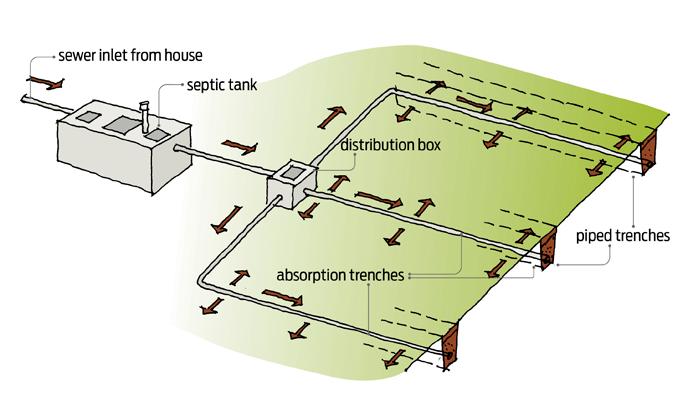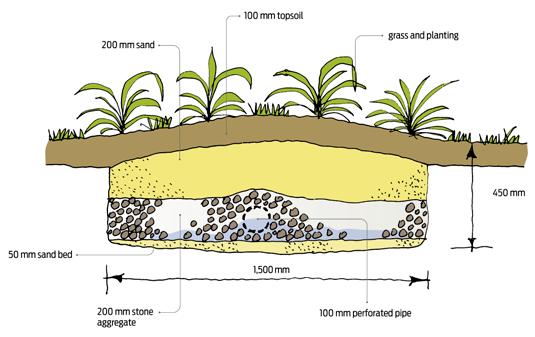
8 minute read
On-site wastewater management
If a property does not have a connection to the local sewerage system, there are a variety of options for individual wastewater treatment systems.
All homes produce wastewater from their kitchens, bathrooms and laundries. Under the New Zealand Building Code, if a wastewater connection to the town sewerage system is provided, you must use it. Otherwise, your home will need its own wastewater treatment system.
There are a wide variety of treatment and disposal systems available, from the traditional single-chamber septic tank to double and triple tank systems with or without stirrers, pumps and bioreactive media.
Blackwater and greywater
Blackwater is contaminated wastewater from WCs and kitchen sinks. It must be treated and disposed of within the boundaries of the property. Kitchen wastewater contains detergents, fats and other organic matter and can potentially be contaminated by organisms such as Campylobacter, so is classed as blackwater. The laundry tub is usually considered a source of blackwater—think what it may be used for, such as washing the dog, rinsing nappies, rinsing the garden sprayer and more. Greywater is from baths, showers and basins and sometimes wastewater from washing machines. It can be separated at source, treated and usually reused for irrigation and toilet flushing.
AUTHOR: ANN GALLOWAY
Code requirements
The construction and operation of an on-site wastewater treatment system must meet the performance requirements of the Building Code. If the system is designed to AS/NZS 1547:2012 On-site domestic wastewater management, the requirements of the Building Code will be met. Septic tank construction is covered by AS/NZS 1546.1:2008 On-site domestic wastewater treatment units – Septic tanks.
The sanitary plumbing within the house must comply with the requirements of Building Code clause G13 Foul water.
Installing an on-site wastewater treatment system requires a building consent, and

Figure 2: Aerated water treatment system (generalised).
the installation must be carried out or supervised by a certified drainlayer.
Wastewater treatment systems
On-site wastewater treatment systems typically involve two stages—treatment in a tank and disposal on or into the land.
There are many variables when it comes to selecting the right treatment system for a property including: the size of the proposed dwelling —the number of bedrooms the slope and layout of the section soil type surrounding the system for disposal how close the property is to neighbours proximity to waterways local council and subdivision consent conditions access for maintenance power consumption and maintenance costs choosing water-efficient fixtures to reduce load on the system. Primary treatment systems
A traditional septic tank is a passive primary treatment system providing only minimal treatment. Solids settle to form sludge on the tank floor, and lighter materials such as fat and grease form a floating layer of scum.
Some anaerobic (without oxygen) bacterial breakdown of solids occurs in the sludge zone. The liquid effluent, which may still contain small particles of solids, flows out of the septic tank via an outlet filter to a land-application disposal area. The effluent percolates through the soil, where it is neutralised by bacterial action (see Figure 1).
The sludge must be pumped out of the tank every 3–5 years, depending on use. A twinchamber tank may require more frequent desludging because the bulk of sludge settles in the first chamber. The outlet filter also requires regular cleaning. Waste disposal units must not be used with septic tanks. Secondary treatment systems
In many areas, a secondary treatment system is the only option permitted. These are typically proprietary systems, requiring specialist design, installation and maintenance. Most systems require electricity to operate pump(s) and a malfunction alarm. However, there are systems available that use gravity and do not require power.
Aerated water treatment systems (AWTS) and advanced sewage treatment systems are secondary treatment systems involving both anaerobic and aerobic (with oxygen) treatment to a higher level than a primary treatment system. The resulting effluent is suitable for irrigation of gardens (excluding fruit and vegetables) and general landscape plantings.
In an AWTS, wastewater flows through a series of chambers or tanks that progressively treat and filter it (see Figure 2). The process involves anaerobic treatment, aeration, clarification and dispersal. Bioreactive media may be used in the second stage to increase bacterial treatment. The media provide an extensive surface area for bacteria to operate. Air is typically provided by a rotating impeller or a pump.
An advanced sewage treatment system (ASTS) treats wastewater in a process similar to AWTS, but after this uses further filtration where micro-organisms treat any remaining fine solids before the effluent is pumped to the disposal field.
Filtration is typically via a sand filter or a packed bed reactor.
These systems may have lower operational and maintenance costs, and some can be managed remotely via the internet. Further treatment can be provided by: recirculating the effluent several times over the filter/reactor bed
Disinfection—chlorine, UV or ozone dosing.
The final effluent is almost clear and odourless and can be used as non-potable water for toilet flushing, vehicle washing and firefighting.
Alternative treatment systems
Vermiculture—worm farm: • Uses earthworms to digest waste material • Proprietary system, must be installed by professionals • The worm casts (solids) are a hazardous substance and must be collected by a waste collection contractor who can dispose of them in an authorised manner. Peat bed treatment: • Peat is used as a filter material for primary septic tank effluent by intermittent dosing • Can produce effluent to a secondary quality standard suitable for irrigation, with minimal maintenance • Design and construction should allow for easy removal and replacement of the peat • Requires specific design, monitoring and reporting to demonstrate design assertions. Constructed subsurface flow wetland: • A shallow gravel media bed with an impermeable membrane or clay lining is planted with wetland species, providing secondary treatment of the effluent • Low energy costs and potential aesthetic/ecological benefits • Requires expert, site-specific design including plant selection.
Disposal systems
Gravity soakage (septic tanks only)— perforated drains are laid in trenches filled with aggregate. The effluent trickles through the aggregate into the surrounding soil where it is neutralised by naturally present bacteria. Typically, the effluent does not spread evenly through the drainage field, as most of it discharges near the beginning of the drainage lines.
Low-pressure effluent distribution/ dose loading (septic tanks only)—a controlled volume of effluent (dose) is pumped through perforated pipes laid in gravel-filled trenches. Dosing occurs at regular intervals over a 24-hour period, ensuring the effluent is spread over the whole drainage field, allowing the ground a rest period between soakings and eliminating the chance of disposal surges that may occur during periods of high household use. Refinements include: • nesting the dose line in a perforated drainage coil to give more even dispersal • using a divertor box to distribute effluent to different parts of the disposal field to avoid oversaturation.
The land used for primary-treated wastewater disposal must not be used for growing food or fruit crops. A reserve area for future wastewater disposal may also be a requirement.
Common methods for disposal of secondary-treated wastewater include dripline irrigation and evapotranspiration systems.
Figure 3: Evapotranspiration trench.

FRANCHISES AVAILABLE
DrainPro has franchise opportunities available around the country. Whether you are an existing company struggling or a tradesman looking to go out on your own, we have the experience, systems and industry contacts to help you develop a successful business. We are members of the Franchise Association of New Zealand (FANZ), and can give you all the assistance you need in deciding if a franchise is the right thing for you. Contact Nathan to register your interest nathan@drainpro.co.nz

www.drainpro.co.nz
Figure 4: Simple greywater system.

Drip-line irrigation systems—also known as pressure-compensating drip irrigation systems—include: • Subsurface—drip lines are buried in topsoil 100–150 mm deep • Surface—drip lines are laid on the surface and covered in bark or mulch • Spray system—treated and disinfected effluent is sprayed over the ground surface. The effluent is pumped, ensuring even distribution over the whole effluent field. Evapotranspiration systems— perforated pipes are laid in wide, gravel-filled trenches (see Figure 3). The overlying soil is planted with specific shallow-rooted plants that absorb effluent through their roots, releasing water into the atmosphere through their leaves in a natural process of transpiration. Effluent not taken up by plants is absorbed into the soil or evaporates. Sand-based systems—these may be used where conventional trenches are unsuitable due to a high water table or poor soil percolation. Sand is mounded to at least 600mm depth, and the effluent trickles through the mound into the underlying soil.
Intermittent sand filter with geotextile base lining and bottomless sand filters (without base lining) may be suitable in certain soil conditions. Effluent is normally dose loaded (timer-controlled) to ensure even distribution.
Greywater system
A greywater system provides settling and filtration to reduce scum and solids (see Figure 4). If greywater is stored for long, it will stagnate, creating harmful toxins, so it should be reused soon after it is treated when toxins and scum are at the lowest levels.
Even after treatment, greywater is not safe for consumption and should only be used for reintroduction to the environment.
A greywater system: reduces the load on sewerage systems reduces the demand on other sources of water provides a garden water supply— unsuitable for vegetables or for sprinklers can be used for toilet flushing if treated— filter, disinfect and treat to remove odours is not universally accepted—consult with the local authority should not reuse kitchen wastewater— laundry wastewater may also contain cleaning chemicals and bacteria should meet the requirements of the Building Code if designed to
AS/NZS 1547:2012 should have drainage installation to
Building Code G13/AS1 must be designed and installed with care—proprietary systems are available should have a bypass valve so the greywater can be sent directly into the sewer or on-site blackwater treatment system if required requires regular maintenance, in particular cleaning or replacing filters requires separate pipework for both drainage and reticulation of recycled water; essentially doubling up on costs.
RESOURCES & FURTHER INFORMATION
BRANZ Level website: www.level. org.nz/water/wastewater/on-sitewastewater-treatment Greater Wellington Regional Council: www.gw.govt.nz/onsite-wastewater Bay of Plenty Regional Council: Technical guidelines: Installing trenches, beds and mounds Auckland Council: Onsite wastewater management in the Auckland Region
This article by Ann Galloway is reproduced from BRANZ Build 184 (June 2021). Build magazine is published by BRANZ, an independent research organisation that provides impartial, evidence-based advice on building and construction issues. www.buildmagazine.org.nz










